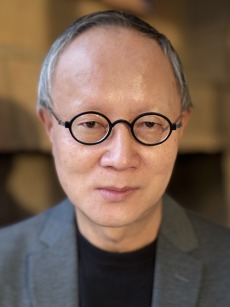
Hai Ren (任海) is Professor of East Asian Studies and Anthropology, and affiliated faculty in the School of Art, the Department of Gender and Women’s Studies, and Graduate Interdisciplinary Programs in Social, Cultural & Critical Theory, and Applied Intercultural Arts Research at the University of Arizona. He directs the Wanwu Arts Research Lab and co-directs the Library of the More-Than-Humane. He is also Bayu Scholar Distinguished Professor in the Department of Sculpture at Sichuan Fine Arts Institute in Chongqing, a top-ranking sculpture program in China. He received his BA in History and Archeology from Sichuan University in Chengdu, China, and a MA in Museum Studies and a Ph.D. in Sociocultural Anthropology from the University of Washington in Seattle. His current teaching and research interests include research-oriented art, public culture, new materialism, environmental humanities, comparative media and technology studies, urban studies, critical theory, and political philosophy. His interdisciplinary publications include studies of socially engaged art, research-oriented art, public history, new materialist anthropology, urban studies, comparative media and technology, popular culture, and critical theory. They reflect Professor Ren's commitment to more-than-Asian studies. His recent work has appeared in Societas/Communitas, Verge: Studies in Global Asias, Screen Bodies, Art Observation, The Art Newspaper China, Mediapolis, Journal of Urban Affairs, Journal of Korean and Asian Arts, China Review International, and Pacific Affairs. His forthcoming book focuses on research-oriented art and generative aesthetics in Sinophone Asia.
Recent Publications & Creative Scholarship
Forthcoming Galsang. An animation film. Co-director and writer, 2026 (Note: This is a story of a human-sheep relationship unfolded in facing environmental pollutions on the Qinghai-Tibet Plateau.)
In Press “The Sinophonecene in More-than-Asian Studies: Planetarity, Habitability, and the Cosmopublic.” In Sinophonecene?: Tracing Environmental and Cohabitational Perspectives in Contemporary Chinese Art. Edited by Franziska Koch, Nora Wölfing, and Cila Brosius. Singapore: Palgrave Macmillan, February 2026.
2025 “More-than-Human: 一种超越人类中心主义的艺术与理论实践—任海教授专访” (The More-than-Human as a Kind of Postanthropocentric Arts and Theories: An In-depth Interview with Professor Hai Ren),《艺术人文学报》(The Journal of Arts and Humanities), December 2025, Vol. 1, Issue 2, pp. 3-12.
2025 “深度感知审美:在数字技术人类世中 “阅读”研究型艺术” (Deep Aesthetics:Reading Research-Based Arts in the Digital Data-Driven Anthropocene).《美术观察》(Art Observation). No. 9, pp. 23-26.
2024 “Under the More-Than-Human Condition: How Does Research-Based Art Engage the Planetary Crises of Climate Change and Social Catastrophes?” Annals of the Library of the More-Than-Humane. The University of Arizona, Vol. 1, 2024. https://more-than-humane.org.
2024 “大于人类的条件下:研究型艺术如何应对气候变化和社会灾难的全球危机?”Annals of the Library of the More-Than-Humane. The University of Arizona, Vol. 1, 2024. https://more-than-humane.org.
2023 “装配世界公众: 艺术智能和物导向的公民身份” (Assembling the Cosmopublic: Art Intelligence and Object-Oriented Citizenship). Trans. by Zhang Xiaoxi (张小溪).《文化与诗学》(Culture and Poetics). Vol. 34, No.1, pp. 88-95.
2023[2022] “Creative Authorship and the Aesthetics of Contemporaneity: Socially Engaged Art and Precarious Subjects in the Chinese Creative Economy.” Societas/Communitas. Vol. 34, Issue 2, pp. 225-248 (published in September 2023). DOI: 10.55226/uw.S.-C.2022.34.2.6
2023-2123 “100-Year Photography: From Today to the Future.” Public art installation at Yangdeng, Guizhou, China, June 22, 2023, 10:00 AM - June 21, 2123, 9:59 AM. Website: https://vimeo.com/842911159
2022 “Planetary Art in the Sinophonecene: An Introduction.” Verge: Studies in Global Asias. Vol. 8, Issue 2 (Fall), pp. 24-27.
2022 “Postanthropocentric Art in the Planetary Age.” Verge: Studies in Global Asias. Vol. 8, Issue 2 (Fall), pp. 27-30.
2022 “Bodies at Ruins: Scenes of the Great Acceleration.” Verge: Studies in Global Asias. Vol. 8, Issue 2 (Fall), pp. 30-33.
2022 “Artistic Critique of the Colonial Plant Ecology.” Verge: Studies in Global Asias. Vol. 8, Issue 2 (Fall), pp. 33-36.
2022 “什么是参与式艺术美术馆?⸺来⾃中国’⽺蹬艺术合作社’的答案” (What is the Socially Engaged Art Museum? Answers from the Yangdeng Art Collective in China). In《中国艺术乡建》(Rural Reconstruction through Art in China). Vol. 2. Edited by Huang Zheng, pp. 125-142. Beijing: People’s Fine Arts Publishing House.
2022 “感知审美、历史体制、星球性的未来主义:来⾃第15届卡塞尔⽂献展现场的反思”(Reflections on the Art of Lumbung at Documenta Fifteen: Aisthesis, Historical Regimes, and Planetary Futurism). The Art Newspaper (《艺术新闻/中文版》), pp. 36-38. Aug 23, 2022. Web site: http://www.tanchinese.com/archives/feature/72475
2022 “Aesthetics of Futurism: Lu Yang’s Art and an Organological Redefinition of the Human in the Planetary Age.” Screen Bodies. Vol. 7, Issue 1 (Spring), pp. 93-110. DOI: 10:3167/screen.2022.070106
2021 “The Aesthetic Scene: A Critique of the Creative Economy in Urban China,” Journal of Urban Affairs. Vol. 43, no. 7, pp. 960-974, DOI: <10.1080/07352166.2018.1443011> (Print version of 2018 online version).
2021 “Infrastructure as a Planetary Sculpture: The Future of the Belt and Road Initiative in the Anthropocene.” An invited essay for “The Belt and Road in Global Perspective,” a joint project by the University of Toronto, Nazarbayev University (Kazakhstan), and National University Singapore. Published by the Munk School of Global Affairs & Public Policy, the University of Toronto, March 18, 2021. Web: https://munkschool.utoronto.ca/beltandroad/article/infrastructure-as-a-planetary-sculpture-the-future-of-the-belt-and-road-initiative-in-the-anthropocene/
2021 “物导向艺术与当代艺术中的审美物” (Object-Oriented Art and the Aesthetic Object in Contemporary Art). 《山东社会科学》(Shangdong Social Sciences), no.1 (January 2021), pp. 42-50, 59 (15,560 words). Site: https://mp.weixin.qq.com/s/LrbI6H8fXDF_GNr7Wz4wfw
2020 “What is the Socially Engaged Art Museum? Lessons from the Yangdeng Art Collective in China.” The Journal of Korean and Asian Arts, vol. 1, Spring 2020, pp. 95-115.
2020 “Assembling the Cosmopublic: Art Intelligence and Object-Oriented Citizenship.” Mediapolis: A Journal of Cities and Culture, Vol.5 No. 1, March 6, 2020. Online publication: https://www.mediapolisjournal.com/2020/03/assembling-the-cosmopublic-art-intelligence-and-object-oriented-citizenship/
2020 “参与的艺术:郭开红的自我雕塑” (The Art of Participation: Guo Kaihong’s Self-Sculpturing). In 《参与式艺术的中国现场:羊磴艺术合作社》(Socially Engaged Art in China: Yangdeng Art Cooperative). Edited by Jiao Xingtao and Lou Jing, pp. 166-175. Beijing: People’s Fine Arts Publishing House.
Courses
CHN 245 “Chinese Popular Culture”
CHN/ANTH 410A/510A “Ethnic Diversity in China”
CHN/ANTH 410B/510B “The Anthropology of Contemporary China”
CHN 444/544 “Chinese Media & Culture”
EAS 280 “Gender, Sexuality and Asia”
EAS/PAH 456/556 "Creative Humanities and Art Practices: International Perspectives"
EAS 595 Graduate Colloquium

